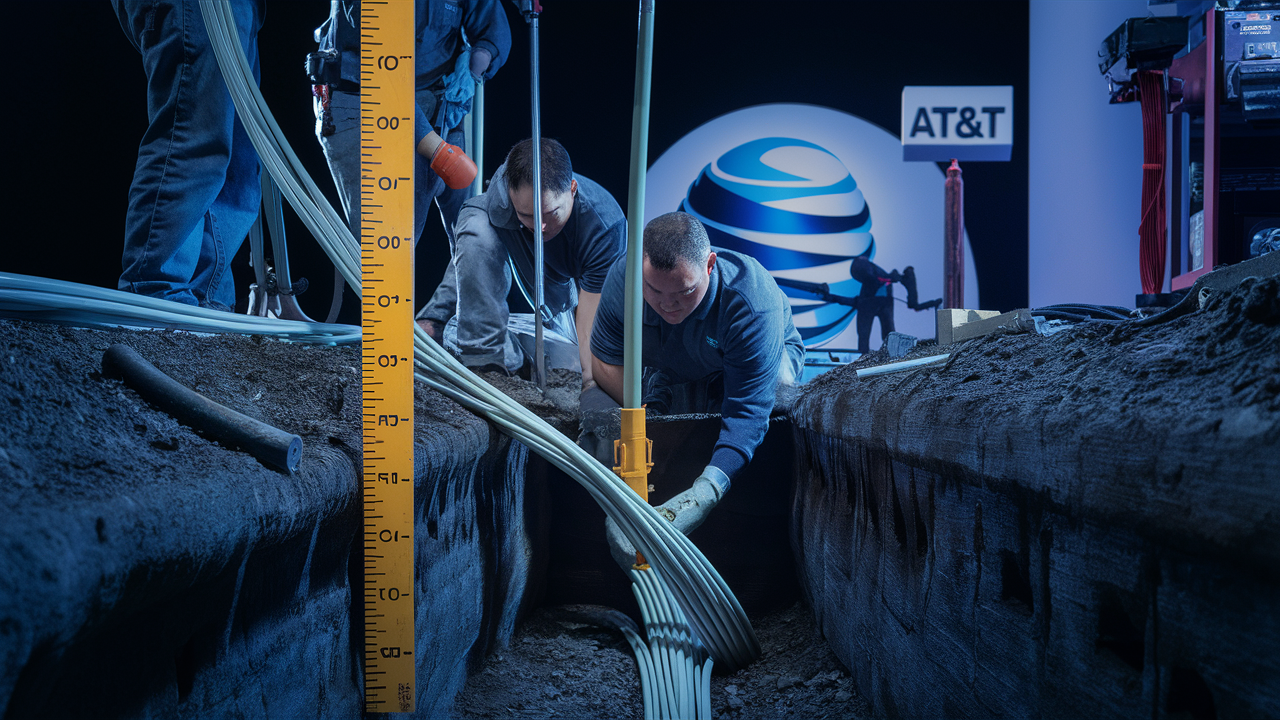How deep is AT&T fiber buried?

It is normally installed at a depth of 18-36 inches below the ground depending on the geographical area and type of soil. This serves to safeguard the cables from harsh weather, physical harm, or interference if the system is to be used for unauthorized purposes.
Why does Fiber Need to Be Buried Deep?
Fiber optic cables transmit data in the form of light signals by using thin strands of glass. Unfortunately, if these fragile fibers are damaged or cracked, then it becomes a problem or is entirely severed. Burying the cables below ground helps protect them from a variety of threats.
- Weather - Freezing, thawing, heavy rain, and temperature changes can affect cables near the surface. A deeper burial maintains cables where the temperature is less likely to fluctuate.
- Negligent damage – Construction crews, gardeners, and other persons who dig without consulting the utility lines are some of the people who cause damage. The cables should be buried deeper into the ground so that it would take more digging to accidentally hit them.
- Rodents & pests – Squirrels, gophers, and other critters can sometimes chew through cables. A deeper burial reduces the likelihood of this happening.
- Vandalism & theft – regrettably some individuals purposefully sever wires and strip cables for copper. This is averted by going deeper.
How Deep AT&T Standards Run?
According to the standards set by AT&T, their fiber optic cables should be buried at a depth of 18-36 inches depending on the area. Here are the typical standards.
- Roads and parking lots – minimum of 36 inches deep. Because vehicles and repaving equipment exert a lot of pressure on the surface, cables require maximum protection.
- Off-road paths & landscaping – 24 inches deep. A 2-foot protective buffer is needed even in areas that do not have vehicle traffic.
- Cropland – 36 inches deep. Usually, 3 feet is used because farm equipment can be very large and cumbersome to move.
- Residential yards – lawns – 18 inches in depth. Even though not as much movement of equipment takes place here, 1.5 feet is considered sufficiently safe.
These standards can also be fine-tuned further depending on the soil type, climate, and other aspects of the network architecture of the particular region.
How Depth Differs by Location?
When it comes to the range of 18-36 inches, there are considerable differences in the burial depth even within a given neighborhood. Here are some reasons why.
- Soil/bedrock - Where soil is loose or sandy, cables may be buried deeper for protection. This may not be possible in rocky areas where the provision of this measurement may be a bit challenging.
- Other utilities – If electric, gas, sewer, or any other underground facility is already present then fiber has to pass over / around the existing infrastructure. This can cause depth inconsistency.
- Terrains - Areas with steep slopes call for shallow trenches on the slopes and deeper ones on the valley slopes to ensure equal coverage.
- Obstructions – When fiber runs by buildings, poles, wells, or other structures that it cannot pass through, depth changes to go around them.
- Technician judgment – The small construction crews that bury the fiber cables make many judgments at dig sites and respond to what they see.
In conclusion, we can see that although the AT&T Internet standard is between 18 to 36 inches, several practical considerations can change the depth in specific zones along a fiber path. Thus, as long as protection and Clearance around other utilities are considered, depth flexibility assists fiber in being placed well.
How Depth is Achieved?
Fiber optics act as a nervous system of a community, and installation is a complex process. After planning a logical cable route, here is the basic process to achieve a target depth.
1. Survey – The existing utility lines are located through electromagnetic scanning or flagging from the relevant utilities. This is where all the infrastructure that is already below ground is illustrated.
2. Permits – Construction permits from the local authorities are procured for the project and dig locations. The labor, traffic control, and other logistical details are managed.
3. Trenching – Concerning the flagged path, backhoes proceed to dig a long and narrow trench alongside where the dirt is heaped. Depth is precisely controlled.
4. Conduit - Plastic conduit piping usually of orange color is placed in sections in the trench to provide a sheath for fiber.
5. Fiber placement – This entails the use of non-binding lubricant while crews unreeled long fiber optic cables in the conduit. Close attention should be paid to the equipment and its usage to prevent microbeads.
6. Backfill & compact – After the digging is done, the soil is put back into the trench and compacted in layers with the help of some machinery.
7. Fiber Path Marking - Colored stakes, paint, and reflectors are used to signify fiber path locations above the ground to ease future excavations.
8. Testing – end-face microscopy ensures that all the fiber strands transmit light correctly from one end to the other without any kind of damage or signal attenuation.
9. Restoration – Where necessary, the landscaping, sidewalks, roads, sod, plants, and other surface materials are restored after backfilling work has been completed.
This integrated process makes it possible for construction crews to meet the required target depth for fiber protection. Another thing that AT&T does is to design conduits with added extra space for the accommodation of extra facilities in later times as and when required for modifications as well as for maintenance. The result is a future-proofed fiber optic infrastructure that is going to last for decades.
Upgrade to faster, more reliable AT&T Fiber Internet today! Call us at +1 844-905-5002 and get connected with speeds that keep you ahead.